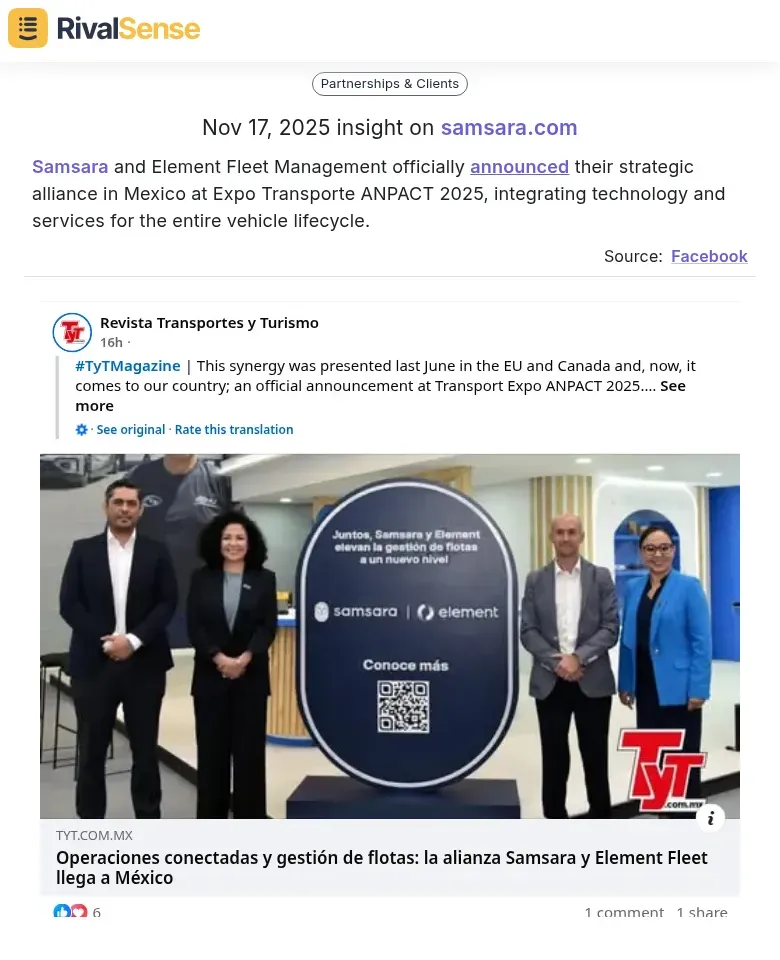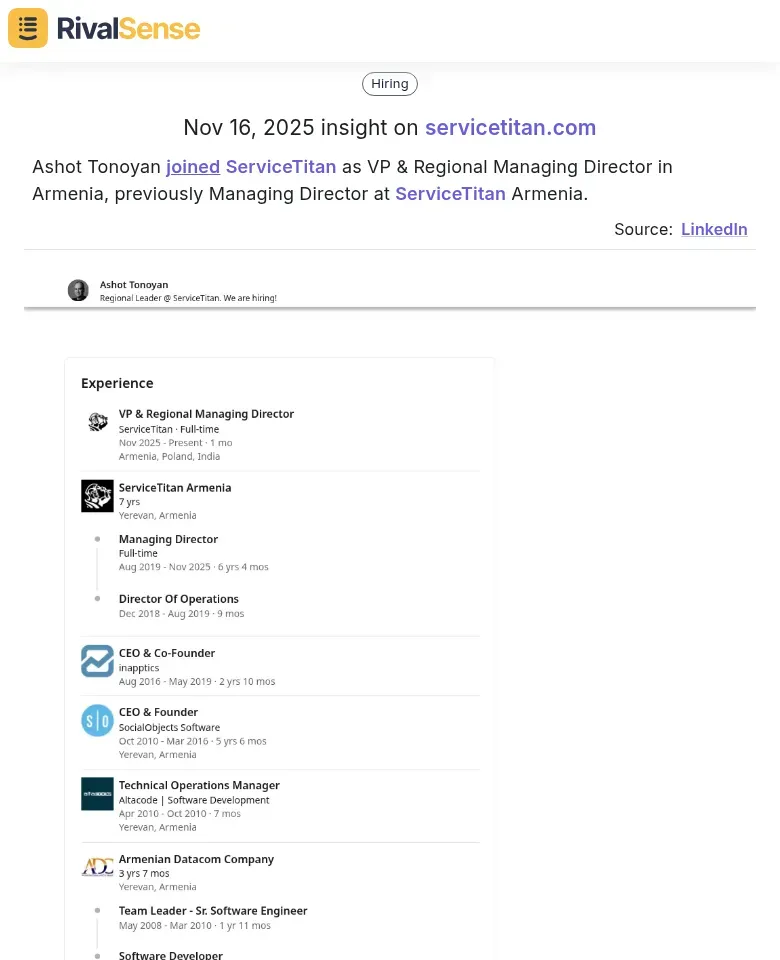Mastering Real-Time Competitor Alerts in Cloud Infrastructure
In the hyper-competitive cloud infrastructure market, real-time competitor alerts are no longer optional—they're essential for survival. The cloud landscape shifts daily with new product launches, pricing changes, and strategic partnerships, making proactive monitoring a cornerstone of strategic agility. Without automated tracking, you risk losing revenue to competitors who launch superior features or undercut your pricing before you even notice, leading to missed opportunities and eroded market share.
Timely alerts transform reactive responses into proactive strategies, enabling swift adjustments to market dynamics. For example, when Samsara launched Commercial Navigation, a smarter, safer routing system for drivers with vehicle-specific restrictions built in, businesses tracking this could immediately assess the competitive threat and innovate their own offerings.  Monitoring product launches like this is invaluable for staying ahead in innovation and customer retention, as it allows you to counter new features quickly and maintain your value proposition.
Monitoring product launches like this is invaluable for staying ahead in innovation and customer retention, as it allows you to counter new features quickly and maintain your value proposition.
Common challenges without automated monitoring include:
- ❌ Missing critical pricing changes that affect deal closures
- ❌ Being blindsided by competitor product launches
- ❌ Wasting hours manually tracking multiple competitors
- ❌ Reacting too slowly to market shifts
Practical steps to implement:
- Identify your top 3-5 direct competitors
- Monitor their pricing pages, feature updates, and press releases
- Set up alerts for key trigger events
- Create response protocols for different scenarios
- Review alert effectiveness monthly and adjust thresholds
Start with monitoring competitor websites, social media, and industry news to detect changes rapidly and maintain your competitive edge.
Setting Up Effective Competitor Alerts: Key Metrics and Triggers
Effective competitor alerts begin with a clear focus on the metrics that matter most to your business. By identifying key activities like pricing adjustments, feature launches, and strategic announcements, you can build a monitoring system that delivers actionable insights. This proactive approach ensures you're always aware of shifts that could impact your market position and customer decisions.
Choose alert triggers that align directly with your business goals, such as growth, retention, or expansion. For instance, if accelerating growth is a priority, set triggers for competitor promotions or entry into new regions. Use tools like RivalSense to customize these triggers based on real-time data, ensuring you capture relevant events without unnecessary noise.
Checklist for configuring alerts:
- 🔧 Start with high-priority triggers (e.g., major price drops)
- 🔧 Gradually add medium-priority ones (e.g., blog posts or minor updates)
- 🔧 Set frequency caps (daily or weekly digests) to avoid alert fatigue
- 🔧 Regularly review and adjust thresholds based on market feedback
By fine-tuning sensitivity and focusing on impactful metrics, you can stay agile and responsive without drowning in notifications.
Tools and Technologies for Real-Time Competitor Monitoring
Selecting the right tools is critical for efficient and accurate competitor monitoring in the fast-paced cloud infrastructure sector. Platforms that offer real-time updates, customizable dashboards, and robust integration capabilities can streamline data collection and enhance decision-making. Without the proper technology, you might miss subtle market shifts or waste resources on manual tracking.
Prioritize tools like RivalSense that provide real-time alerts on pricing changes, feature launches, and market positioning, integrated with your existing systems. For example, look for API access to automate data flow into CRMs like Salesforce or HubSpot and BI tools like Tableau or Power BI, reducing manual effort and ensuring seamless insights.
Actionable tips for tool evaluation:
- 🛠️ Assess accuracy and update frequency through free trials
- 🛠️ Use APIs to automate data ingestion into your workflows
- 🛠️ Set up alerts for critical events, such as competitor outages or service announcements
- 🛠️ Combine quantitative data (e.g., pricing trends) with qualitative insights (e.g., customer reviews) for a holistic view
Avoid tools that lack real-time capabilities or flexible integrations to maintain agility and responsiveness in a dynamic market.
Analyzing and Acting on Competitor Alerts: Strategic Responses
In the fast-paced cloud infrastructure market, real-time competitor alerts are only valuable when paired with a structured response framework. Start by categorizing alerts into tiers to prioritize actions and allocate resources effectively, ensuring that urgent threats are addressed promptly while informational updates are used for trend analysis. This approach prevents overwhelm and focuses efforts on what truly impacts your business.
For instance, when Samsara and Element Fleet Management officially announced their strategic alliance in Mexico, it underscored the importance of tracking partnerships.  Insights into alliances like this are valuable for identifying new market opportunities or threats, enabling you to form counter-strategies, such as enhancing your own collaborations or highlighting unique differentiators to customers.
Insights into alliances like this are valuable for identifying new market opportunities or threats, enabling you to form counter-strategies, such as enhancing your own collaborations or highlighting unique differentiators to customers.
Tier-based response checklist:
- 🚨 Tier 1 (Urgent): Immediate action for major pricing drops or product launches—assess impact on market share and align with long-term goals within 48 hours
- 📊 Tier 2 (Important): Analysis within days for feature updates—evaluate resource allocation and potential countermeasures
- ℹ️ Tier 3 (Informational): Trend tracking for blog posts or minor announcements—use for ongoing strategy refinement
Avoid reactionary decisions by validating data first; for example, don't blindly match a price cut if it harms profitability. Instead, leverage alerts to pivot offerings, as seen when a startup capitalized on a rival's API downtime to emphasize reliability, gaining significant market share.
Measuring the Impact of Competitor Alerts on Business Performance
To truly gauge the effectiveness of competitor alerts, it's essential to track key performance indicators that reflect business outcomes. Metrics like market share, customer retention, and revenue growth provide a clear picture of how alert-driven decisions influence your bottom line. Without this measurement, you might continue investing in monitoring without realizing tangible benefits.
Use tools like Google Analytics or CRM dashboards to monitor these KPIs before and after implementing alerts, correlating actions with results. For example, if an alert about a competitor's price drop leads you to adjust pricing, analyze changes in sales volume or customer acquisition costs to assess impact.
Steps for impact measurement:
- 📈 Set up A/B testing to compare teams using alerts versus those that don't
- 📈 Create a feedback loop with sales and marketing teams to identify which alerts drive actionable insights
- 📈 Regularly review and refine alert criteria based on effectiveness data
- 📈 Remove low-impact alerts and add new ones aligned with emerging trends
This iterative approach ensures your competitor tracking remains relevant and directly contributes to business improvements.
Future Trends: The Evolution of Competitor Intelligence in Cloud
The future of competitor intelligence in cloud infrastructure is being reshaped by advanced technologies and global dynamics, offering new ways to anticipate and respond to market shifts. AI and predictive analytics are at the forefront, enabling businesses to forecast competitor moves with greater accuracy by analyzing patterns in pricing, feature launches, and strategic positioning.
Regulatory and ethical considerations are also gaining prominence, requiring businesses to balance intelligence gathering with compliance. For example, tracking leadership changes, such as when Ashot Tonoyan joined ServiceTitan as VP & Regional Managing Director in Armenia, can provide early signals of strategic shifts.  This type of insight is valuable for anticipating new market entries or changes in company direction, helping you adapt your strategy proactively while adhering to data privacy laws.
This type of insight is valuable for anticipating new market entries or changes in company direction, helping you adapt your strategy proactively while adhering to data privacy laws.
Checklist for future preparedness:
- 🌍 Monitor emerging markets for expansion opportunities
- 🌍 Track regulatory changes in target regions
- 🌍 Analyze competitor partnerships and M&A activity
- 🌍 Assess geopolitical factors affecting cloud infrastructure
Leverage AI-powered tools for predictive alerts on competitor strategies, and stay ahead by anticipating consolidation and regulatory shifts before they impact your business.
Ready to Elevate Your Competitor Intelligence?
Implementing real-time competitor alerts can transform how you navigate the cloud infrastructure landscape, turning potential threats into opportunities for growth. By leveraging tools like RivalSense, you can automate tracking of product launches, pricing updates, partnerships, and more, all delivered in a concise weekly report.
Try RivalSense for free today at https://rivalsense.co/ and get your first competitor report to start making smarter, faster decisions. Don't wait—gain the insights you need to stay ahead in this competitive market!
📚 Read more
👉 How RivalSense Enabled Competitors to Counter Folksam's Market Moves
👉 Instagram Competitor SWOT Analysis: Uncover Strategic Insights
👉 Advanced Tactics: Uncover Your Competitors' Aviation Edge
👉 Mastering Market Entry with Competitor Win-Loss Analysis
👉 Real-World Competitor Analysis: Tracking Leadership Changes
